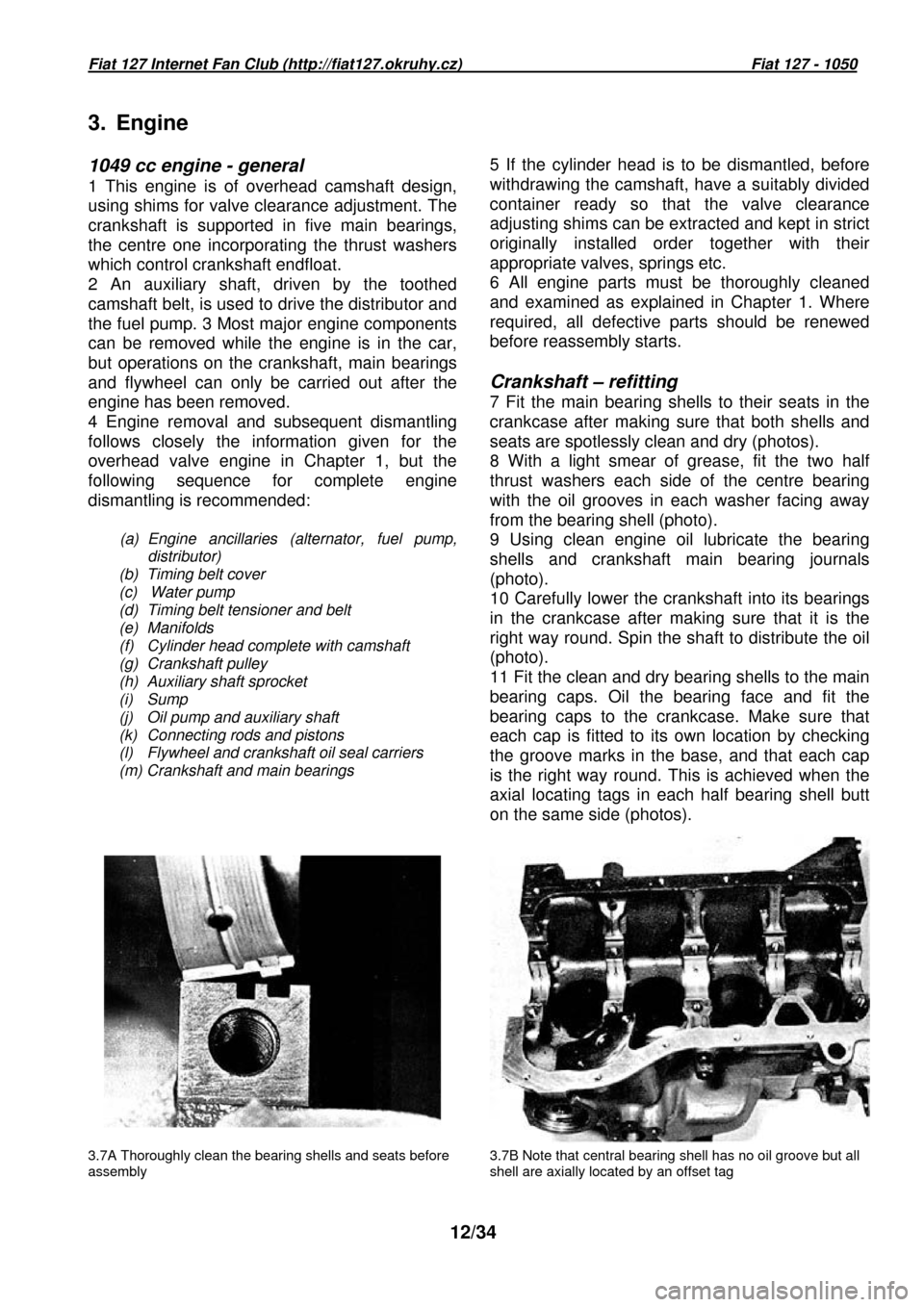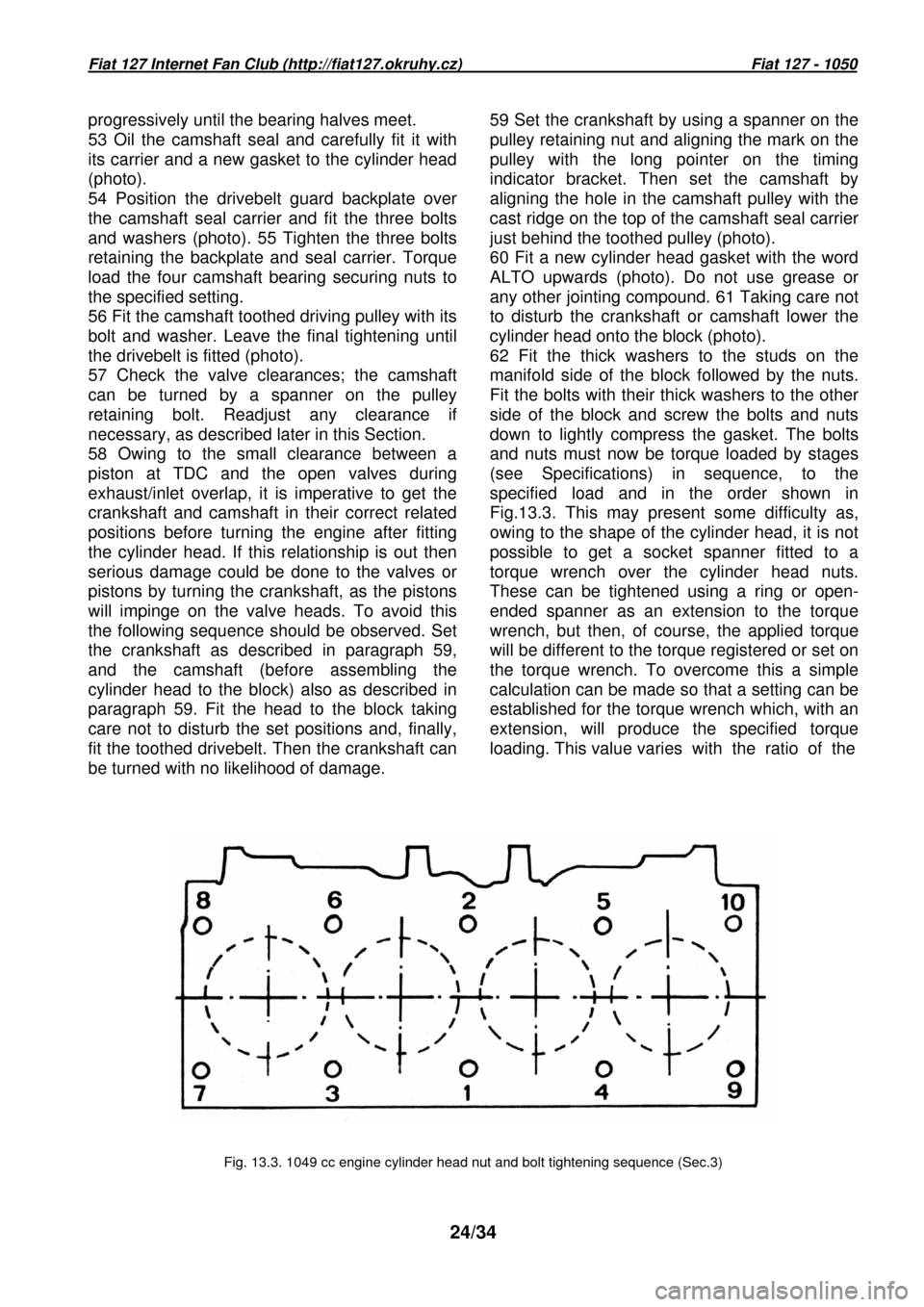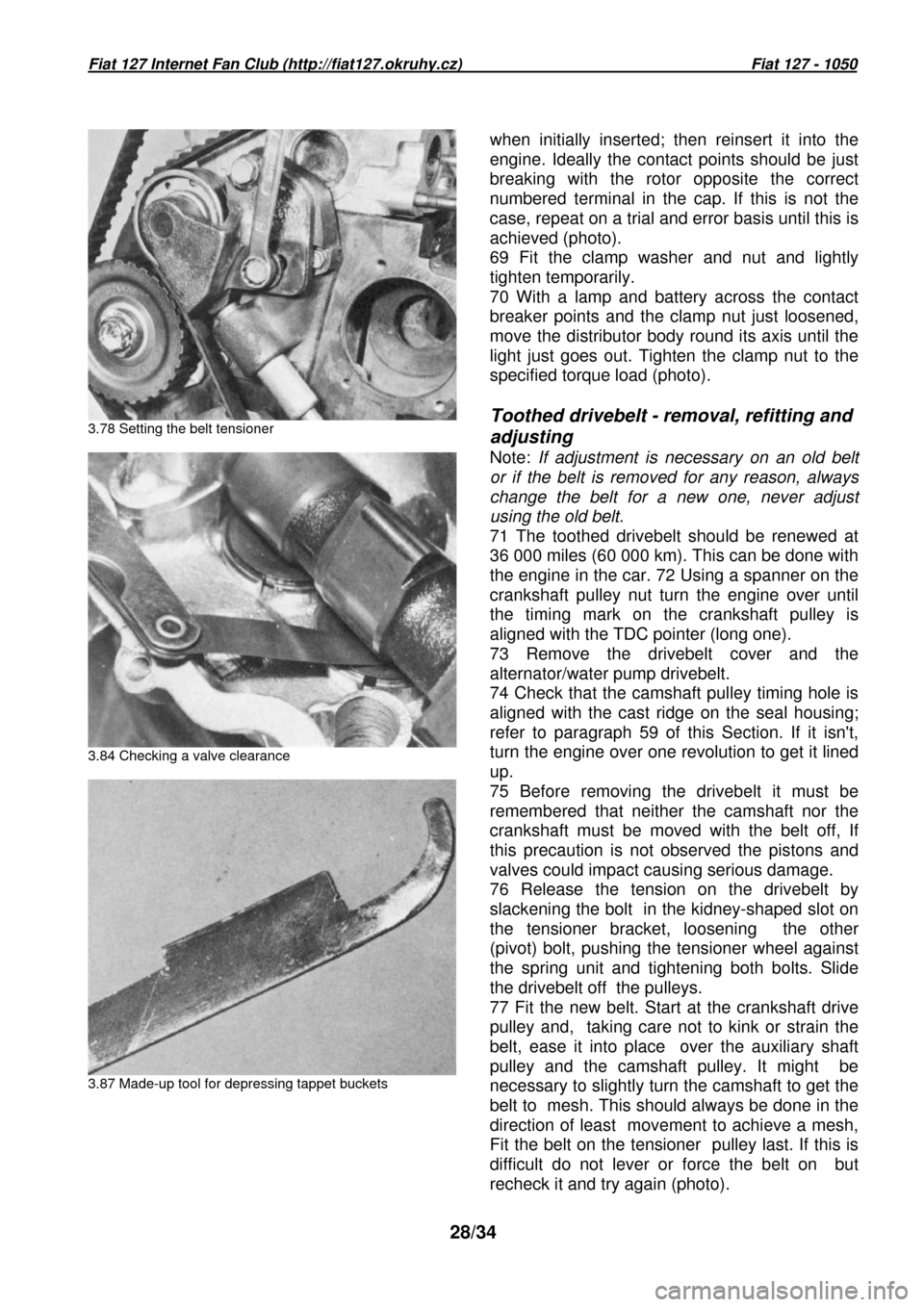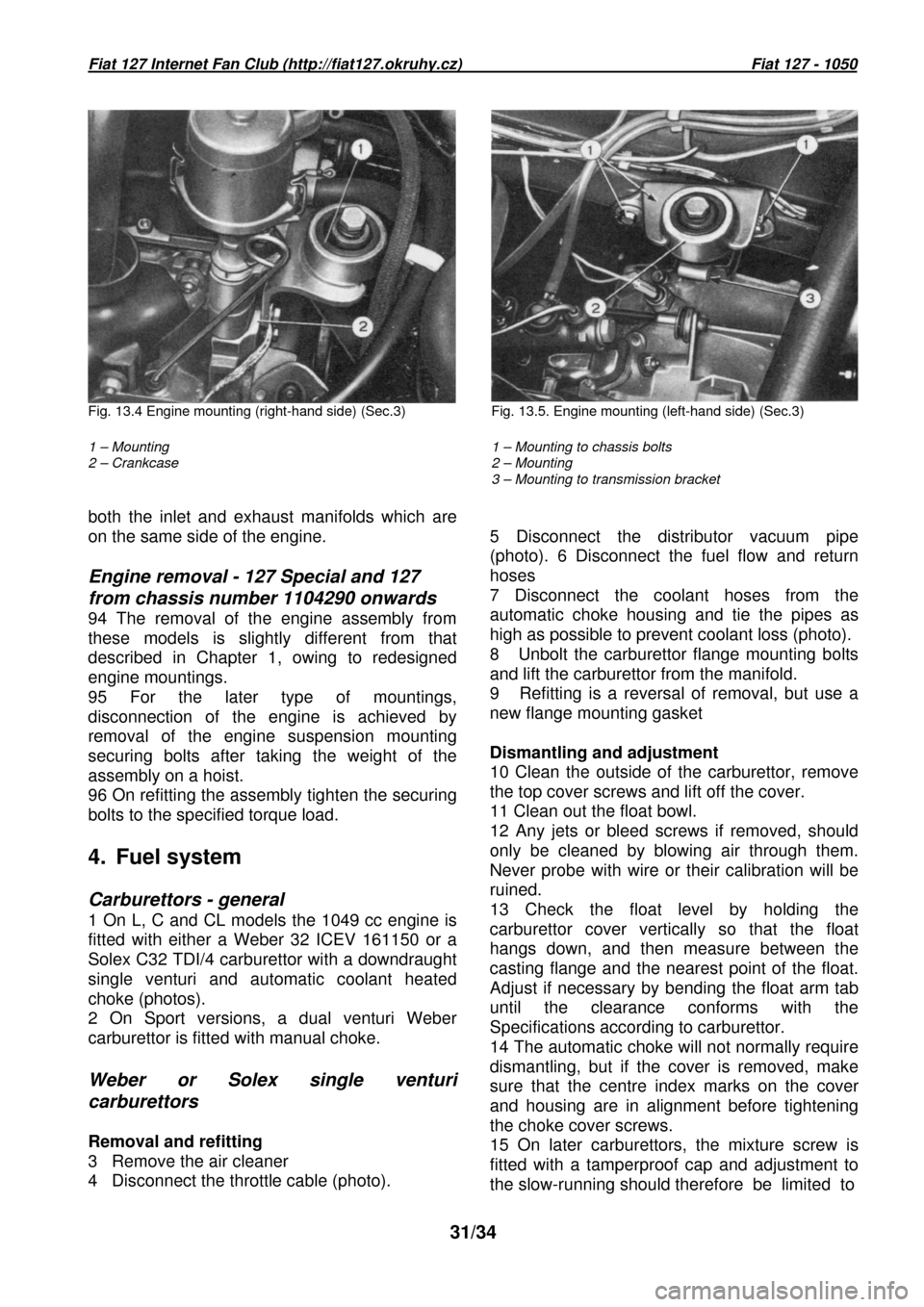check engine light FIAT 127 1981 2.G Workshop Manual
[x] Cancel search | Manufacturer: FIAT, Model Year: 1981, Model line: 127, Model: FIAT 127 1981 2.GPages: 34, PDF Size: 6.87 MB
Page 12 of 34

Fiat 127 Internet Fan Club (http://fiat127.okruhy.cz) Fiat 127 - 1050
12/34
3. Engine
1049 cc engine - general
1 This engine is of overhead camshaft design,
using shims for valve clearance adjustment. The
crankshaft is supported in five main bearings,
the centre one incorporating the thrust washers
which control crankshaft endfloat.
2 An auxiliary shaft, driven by the toothed
camshaft belt, is used to drive the distributor and
the fuel pump. 3 Most major engine components
can be removed while the engine is in the car,
but operations on the crankshaft, main bearings
and flywheel can only be carried out after the
engine has been removed.
4 Engine removal and subsequent dismantling
follows closely the information given for the
overhead valve engine in Chapter 1, but the
following sequence for complete engine
dismantling is recommended:
(a) Engine ancillaries (alternator, fuel pump, distributor)
(b) Timing belt cover
(c) Water pump
(d) Timing belt tensioner and belt
(e) Manifolds
(f) Cylinder head complete with camshaft
(g) Crankshaft pulley
(h) Auxiliary shaft sprocket
(i) Sump
(j) Oil pump and auxiliary shaft
(k) Connecting rods and pistons
(l) Flywheel and crankshaft oil seal carriers
(m) Crankshaft and main bearings
5 If the cylinder head is to be dismantled, before
withdrawing the camshaft, have a suitably divided
container ready so that the valve clearance
adjusting shims can be extracted and kept in strict
originally installed order together with their
appropriate valves, springs etc.
6 All engine parts must be thoroughly cleaned
and examined as explained in Chapter 1. Where
required, all defective parts should be renewed
before reassembly starts.
Crankshaft – refitting
7 Fit the main bearing shells to their seats in the
crankcase after making sure that both shells and
seats are spotlessly clean and dry (photos).
8 With a light smear of grease, fit the two half
thrust washers each side of the centre bearing
with the oil grooves in each washer facing away
from the bearing shell (photo).
9 Using clean engine oil lubricate the bearing
shells and crankshaft main bearing journals
(photo).
10 Carefully lower the crankshaft into its bearings
in the crankcase after making sure that it is the
right way round. Spin the shaft to distribute the o il
(photo).
11 Fit the clean and dry bearing shells to the main
bearing caps. Oil the bearing face and fit the
bearing caps to the crankcase. Make sure that
each cap is fitted to its own location by checking
the groove marks in the base, and that each cap
is the right way round. This is achieved when the
axial locating tags in each half bearing shell butt
on the same side (photos).
3.7A Thoroughly clean the bearing shells and seats
before
assembly 3.7B Note that central bearing shell has no oil gro ove but all
shell are axially located by an offset tag
Page 24 of 34

Fiat 127 Internet Fan Club (http://fiat127.okruhy.cz) Fiat 127 - 1050
24/34
progressively until the bearing halves meet.
53 Oil the camshaft seal and carefully fit it with
its carrier and a new gasket to the cylinder head
(photo).
54 Position the drivebelt guard backplate over
the camshaft seal carrier and fit the three bolts
and washers (photo). 55 Tighten the three bolts
retaining the backplate and seal carrier. Torque
load the four camshaft bearing securing nuts to
the specified setting.
56 Fit the camshaft toothed driving pulley with its
bolt and washer. Leave the final tightening until
the drivebelt is fitted (photo).
57 Check the valve clearances; the camshaft
can be turned by a spanner on the pulley
retaining bolt. Readjust any clearance if
necessary, as described later in this Section.
58 Owing to the small clearance between a
piston at TDC and the open valves during
exhaust/inlet overlap, it is imperative to get the
crankshaft and camshaft in their correct related
positions before turning the engine after fitting
the cylinder head. If this relationship is out then
serious damage could be done to the valves or
pistons by turning the crankshaft, as the pistons
will impinge on the valve heads. To avoid this
the following sequence should be observed. Set
the crankshaft as described in paragraph 59,
and the camshaft (before assembling the
cylinder head to the block) also as described in
paragraph 59. Fit the head to the block taking
care not to disturb the set positions and, finally,
fit the toothed drivebelt. Then the crankshaft can
be turned with no likelihood of damage.
59 Set the crankshaft by using a spanner on the
pulley retaining nut and aligning the mark on the
pulley with the long pointer on the timing
indicator bracket. Then set the camshaft by
aligning the hole in the camshaft pulley with the
cast ridge on the top of the camshaft seal carrier
just behind the toothed pulley (photo).
60 Fit a new cylinder head gasket with the word
ALTO upwards (photo). Do not use grease or
any other jointing compound. 61 Taking care not
to disturb the crankshaft or camshaft lower the
cylinder head onto the block (photo).
62 Fit the thick washers to the studs on the
manifold side of the block followed by the nuts.
Fit the bolts with their thick washers to the other
side of the block and screw the bolts and nuts
down to lightly compress the gasket. The bolts
and nuts must now be torque loaded by stages
(see Specifications) in sequence, to the
specified load and in the order shown in
Fig.13.3. This may present some difficulty as,
owing to the shape of the cylinder head, it is not
possible to get a socket spanner fitted to a
torque wrench over the cylinder head nuts.
These can be tightened using a ring or open-
ended spanner as an extension to the torque
wrench, but then, of course, the applied torque
will be different to the torque registered or set o n
the torque wrench. To overcome this a simple
calculation can be made so that a setting can be
established for the torque wrench which, with an
extension, will produce the specified torque
loading. This value varies with the ratio of t he
Fig. 13.3. 1049 cc engine cylinder head nut and bol t tightening sequence (Sec.3)
Page 28 of 34

Fiat 127 Internet Fan Club (http://fiat127.okruhy.cz) Fiat 127 - 1050
28/34
3.78 Setting the belt tensioner
3.84 Checking a valve clearance
3.87 Made-up tool for depressing tappet buckets
when initially inserted; then reinsert it into the
engine. Ideally the contact points should be just
breaking with the rotor opposite the correct
numbered terminal in the cap. If this is not the
case, repeat on a trial and error basis until this
is
achieved (photo).
69 Fit the clamp washer and nut and lightly
tighten temporarily.
70 With a lamp and battery across the contact
breaker points and the clamp nut just loosened,
move the distributor body round its axis until the
light just goes out. Tighten the clamp nut to the
specified torque load (photo).
Toothed drivebelt - removal, refitting and
adjusting
Note: If adjustment is necessary on an old belt
or if the belt is removed for any reason, always
change the belt for a new one, never adjust
using the old belt.
71 The toothed drivebelt should be renewed at
36 000 miles (60 000 km). This can be done with
the engine in the car. 72 Using a spanner on the
crankshaft pulley nut turn the engine over until
the timing mark on the crankshaft pulley is
aligned with the TDC pointer (long one).
73 Remove the drivebelt cover and the
alternator/water pump drivebelt.
74 Check that the camshaft pulley timing hole is
aligned with the cast ridge on the seal housing;
refer to paragraph 59 of this Section. If it isn't,
turn the engine over one revolution to get it lined
up.
75 Before removing the drivebelt it must be
remembered that neither the camshaft nor the
crankshaft must be moved with the belt off, If
this precaution is not observed the pistons and
valves could impact causing serious damage.
76 Release the tension on the drivebelt by
slackening the bolt in the kidney-shaped slot on
the tensioner bracket, loosening the other
(pivot) bolt, pushing the tensioner wheel against
the spring unit and tightening both bolts. Slide
the drivebelt off the pulleys.
77 Fit the new belt. Start at the crankshaft drive
pulley and, taking care not to kink or strain the
belt, ease it into place over the auxiliary shaft
pulley and the camshaft pulley. It might be
necessary to slightly turn the camshaft to get the
belt to mesh. This should always be done in the
direction of least movement to achieve a mesh,
Fit the belt on the tensioner pulley last. If this is
difficult do not lever or force the belt on but
recheck it and try again (photo).
Page 29 of 34

Fiat 127 Internet Fan Club (http://fiat127.okruhy.cz) Fiat 127 - 1050
29/34
78 Slacken the tensioner bolts to tension the belt
and retighten the bolts (photo).
79 Turn the engine over for two complete
revolutions to even out belt tension. Then again
slacken the tensioner bolts to let the tensioner
take up any slack and
retighten the bolts. Never
turn the engine backwards or rock the camshaft
when tensioning the belt, as slack could develop
in the belt and it might jump a tooth.
80 Refit and tension the alternator/water pump
V-belt. Refit the drivebelt cover.
Valve clearances - adjustment
81 Checking the valve clearances should be
done at the 6000 miles servicing, or whenever
the cylinder head has been removed and
refitted for any reason. It is important that the
clearances are set correctly, otherwise the
timing will be wrong and the engine
performance will be poor. If there is no
clearance at all, the valves and seats will soon
get burnt. Set the clearances with the engine
cold.
82 Remove the camshaft cover. The engine can
be turned over by either using a spanner on the
crankshaft pulley nut, or by jacking up a front
wheel, engaging top gear and using the wheel
to turn the engine.
83 Each tappet must be checked when its
operating cam is pointing upwards, 1800 away
from the tappet. Check the clearances in the
firing order, No. 1 cylinder first and then 3, 4
and 2. Do the exhaust of one cylinder and the
inlet of the one after, at the same time to
minimise the amount of engine turning. Counting
from the timing belt end, exhaust valves are
1-4-5-8, inlet valves 2-3-6-7.
84 Insert the feeler gauge for the appropriate
valve. See the Specifications for correct
settings. The feeler should slide in readily
between cam and shim, but with slight frictional
drag. Try one a size thicker and one a size
thinner. The thick one should not go in and the
thinner one should be too loose (photo).
85 If the clearance is wrong, measure the
clearance and write it down with the number of
the valve. When all the clearances have been
checked, it will be necessary to remove those
shims which are fitted where the clearances are
wrong, and renew them with different thickness
shims. If a clearance is too big, use a thicker
shim. If a clearance is too small use a thinner
shim. Calculate by simple subtraction. 86 To change a shim, turn the engine until the
relevant cam is pointing upwards, then turn the
tappet in its housing so that the slot in the rim is
accessible.
87 The manufacturer provides special tools for
depressing tappets (Nos. A60480 and A60443).
These make the job easier if they can be
borrowed, but it is possible to do the job without
them. The best way is to make up a tool from a
piece of steel plate shaped as shown in the
photograph. Alternatively use a screwdriver to
lever the tappet down and another on
e, on edge,
to hold the tappet down by positioning it
between the camshaft and the rim of the tappet;
then remove the lever. This is quite tricky and
needs some care to avoid any damage. If in any
doubt about doing this job it should be left to a
FIAT agent. As well as having the right tools he
will also have a stock of shims from which to
choose those required to correct wrong
clearances. It is expensive buying shims that are
not required (photo).
88 With the tappet held down, prise the shim out
with a thin screwdriver. The FIAT way is to lift
the shim using compressed air, which is
effective if an air line is available. The shims are
held in quite strongly by the oil film and they
must be lifted up square or they will jam.
Remove the shim with long-nosed pliers
(photos).
89 When new, shims have their thickness
marked in millimetres on their undersides. This
marking may wear off and then it will be
necessary to measure their thickness with a
micrometer. From the thickness of the shim and
the error in the clearance, calculate the size of
shim required to produce the correct clearance.
90 Insert the new shim, numbered side down
towards the tappet. Remove the tools used for
depressing the tappet and repeat the operation
until all clearances are correct.
91 Using clean engine oil lubricate all moving
and sliding parts in the camshaft/tappet
assembly. Fit a new gasket and refit the
camshaft cover together with the nine bolts and
washers. Tighten the bolts progressively (photo).
Engine - final assembly
92 Completing assembly of the 1049 cc engine
follows broadly the procedure for that of the
smaller engine which is dealt with in Chapter 1,
Section 56.
93 The manifold gasket is supplied in two parts
for the 1049 cc engine (photo). These serve
Page 31 of 34

Fiat 127 Internet Fan Club (http://fiat127.okruhy.cz) Fiat 127 - 1050
31/34
Fig. 13.4 Engine mounting (right-hand side) (Sec.3) Fig. 13.5. Engine mounting (left-hand side) (Sec.3)
1 – Mounting
2 – Crankcase
1 – Mounting to chassis bolts
2 – Mounting
3 – Mounting to transmission bracket
both the inlet and exhaust manifolds which are
on the same side of the engine.
Engine removal - 127 Special and 127
from chassis number 1104290 onwards
94 The removal of the engine assembly from
these models is slightly different from that
described in Chapter 1, owing to redesigned
engine mountings.
95 For the later type of mountings,
disconnection of the engine is achieved by
removal of the engine suspension mounting
securing bolts after taking the weight of the
assembly on a hoist.
96 On refitting the assembly tighten the securing
bolts to the specified torque load.
4. Fuel system
Carburettors - general
1 On L, C and CL models the 1049 cc engine is
fitted with either a Weber 32 ICEV 161150 or a
Solex C32 TDI/4 carburettor with a downdraught
single venturi and automatic coolant heated
choke (photos).
2 On Sport versions, a dual venturi Weber
carburettor is fitted with manual choke.
Weber or Solex single venturi
carburettors
Removal and refitting
3 Remove the air cleaner
4 Disconnect the throttle cable (photo).
5 Disconnect the distributor vacuum pipe
(photo). 6 Disconnect the fuel flow and return
hoses 7 Disconnect the coolant hoses from the
automatic choke housing and tie the pipes as
high as possible to prevent coolant loss (photo).
8 Unbolt the carburettor flange mounting bolts
and lift the carburettor from the manifold.
9 Refitting is a reversal of removal, but use a
new flange mounting gasket
Dismantling and adjustment
10 Clean the outside of the carburettor, remove
the top cover screws and lift off the cover.
11 Clean out the float bowl.
12 Any jets or bleed screws if removed, should
only be cleaned by blowing air through them.
Never probe with wire or their calibration will be
ruined.
13 Check the float level by holding the
carburettor cover vertically so that the float
hangs down, and then measure between the
casting flange and the nearest point of the float.
Adjust if necessary by bending the float arm tab
until the clearance conforms with the
Specifications according to carburettor.
14 The automatic choke will not normally require
dismantling, but if the cover is removed, make
sure that the centre index marks on the cover
and housing are in alignment before tightening
the choke cover screws.
15 On later carburettors, the mixture screw is
fitted with a tamperproof cap and adjustment to
the slow-running should therefore be limited to